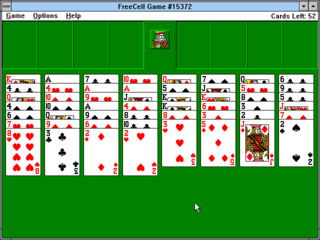Overview
 A standard game of FreeCell in Windows 3.1
A standard game of FreeCell in Windows 3.1FreeCell (also known as Microsoft FreeCell and Free Cell) is a digital card solitaire game developed and published by Microsoft for Windows PCs in 1991 (as part of Microsoft Entertainment Pack 2). It was also included in some OEM desktop computer configurations (along with other games from the Microsoft Entertainment Pack series) and was later included with all installations of the Microsoft Windows operating systems from Windows NT 3.1 to Windows 7.
It is a direct successor to the 1988 MS-DOS game Free Cell, created by the same developer (Jim Horne), and is an unofficial adaptation of the 1979 PLATO game Freecell. The game's rules are based on those from the card game Baker's Game, where players have to manage eight cascades ("columns") of open-faced cards (with the aid of four "free cells" for temporarily storing cards) in order to create four full foundation piles ("home cells") similar to Klondike.
It uses the standard Microsoft card image library (also used in the pack-in game Solitaire) and features a procedural generator for shuffling the cards for the initial deal (where players can generate specific deals by using numbered "seeds", up to seed #32000). Most deals from the original "Microsoft 32,000" are solvable, with only one verified to be unwinnable (seed #11982).
Originally released as part of the second Microsoft Entertainment Pack as a 16-bit application (and was included in the series' "best of" compilation), a 32-bit "Win32s application" version was later included in both the Win32s add-on module (for Windows 3.1) and the Windows NT 3.1 operating system, both for testing purposes. This version was included in subsequent Windows releases (along with other games, namely Solitaire, Minesweeper, and Hearts), where it gained in popularity.
It also received new features in newer Windows versions, such as more playable seeds (up to one million) and the ability to undo moves (first with only one move at a time, then with unlimited moves at a time). The version of the game included in both Windows Vista and Windows 7, developed in part by Oberon Games, features enhanced graphical updates, a drag-and-drop system (similar to Solitaire), the added ability to save and restore in-progress games, and a new hint system. It also features new themes for both the card deck (Classic, Hearts, Seasons, and Large Print) and the background (Classic Felt, Red Hearts, Green Nature, Red Felt, and Brown Felt) and supports the Windows Media Center service for use with TVs.
Beginning with Windows 8, the game itself is no longer included in Windows installations. However, a successor to it is available as part of the free-to-play Microsoft Solitaire Collection. Like other pack-in games that are kept when upgrading the Windows operating system, the base installation of the pack-in version of FreeCell is removed completely once an April 2018 update of Windows 10 is applied.
The game was also included in the Game Boy Color port of The Best of Microsoft Entertainment Pack.
Gameplay
FreeCell utilizes three different areas of the game board: the main layout (with eight "columns"), the top-left area (with the four "free cells") and the top-right area (with the four "home cells"). The game itself can be played using either Mouse (where players click on cards/columns) or Keyboard. With the keyboard, the game is played with the number keys (either on the main layout or on the numeric keypad with Num Lock enabled) and use the following layout:
- '1' key to '8' key for each column, left to right. Pressing the key again de-selects it while displaying each card sequentially (for those having trouble viewing them).
- '0' key for the free cells. When selecting a card, pressing the key cycles through each cell. Pressing the key while selecting the last used cell de-selects them.
- '9' key for the home cells. It is only used for transferring a card to the home cells.
While players choose where to move card stacks, much of the game's movement involving free cells (such as moving a multi-card stack to a different column) is done automatically.
Game Rules
The objective of FreeCell is to move all cards in a standard 52-card deck from the eight columns to the four home cells, where each home cell should contain all cards of the same suit in an ascending order (A, 2-10, J, Q, K).
From the start, cards are dealt face-up into all eight columns, with seven cards in the leftmost four columns and six cards in the rightmost four columns.
Each bottom-most card in the column (as well as the card occupying a free cell) can only be moved into one of three locations:
- The bottom of another column, where the card above it must be one rank higher and of an alternate suit color (Diamond/Heart or Spade/Club).
- An unoccupied free cell. Note that keeping these cells occupied makes it more difficult to transfer stacks of cards.
- The home cell of the same suit, as long as the card in that cell is one rank lower. Aces are automatically moved into the home cell.
Log in to comment